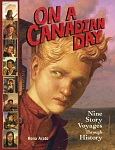Pistes d'exploration
: Browse the book, noting the features and organization. Locate the settings of each story on a map of Canada.
:
Choose an aspect of life that is featured in the stories such as food, shelter or education. Compare it across several of the stories using a graphic organizer.
: Work with a partner and choose one of the stories to focus on. Compare and contrast the protagonist’s life with yours. Discuss the era you would prefer to live in.
:
Write a similar story set in the current year. Imagine it is being read by an audience 100 years in the future. Integrate facts about modern life with either a personal or a fictional narrative.
:
Based on the cover, make predictions about the content. Explore the structures and features of the book. How is it organized?
:
Identify the main characters and settings of the nine stories. Indicate the settings on a map, using sticky notes with the characters’ names. Add cards with the characters and settings to the classroom timeline.
:
Participate in the modelling of a mind map for the first story. In small teams, create a mind map for one of the other texts. Compare with your own life. Share your understanding of the story with the other teams.
:
Browse through the book, noting the features and organization. Label the settings on a map of Canada, adding the date of each story.
:
Create a storyboard for one of the stories and illustrate its important moments.
:
Since 1979, many people have left their home countries for Canada. Research other immigrants and create a scrapbook page with a map, facts and photos, using the book as your model. Assemble these pages into a class book.
Mots-clés
Non-fiction, Canadian history, children, immigration, multiple stories, narrative non-fiction


